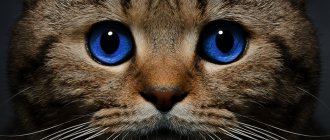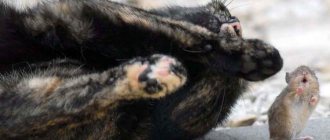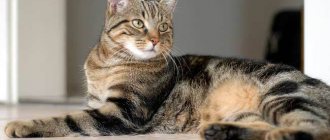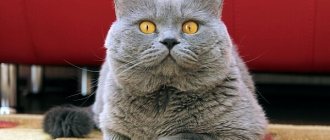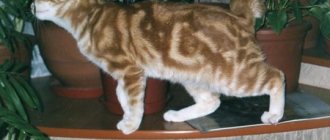One of the most popular breeds in the world is the Persian cat . Persians are loved not only for their exceptionally chic and beautifully colored fur coat, but also for their wonderful peace-loving character. Keeping such a four-legged friend in the house is true happiness for a person who loves cats. Of course, such happiness requires increased attention precisely because of its external characteristics: the structural features of the jaw and the physiology of the cat do not tolerate a careless approach to nutrition, and grooming is a serious and obligatory procedure. But this does not stop those who want to have such a fluffy and affectionate beauty in their home.
History of the origin of the Persian cat breed
global $ads_google;
//data-ad-slot=”2475549904″ $ads_google = empty($ads_google) ? false : true; ?> if ($ads_google == false) {?> $ads_google = true; ?> } ?> Traveling through the Persian province of Harassan, the Italian Pietro Della Valle returned to his homeland not alone, but with several long-haired cats at the beginning of the 16th century. Outwardly, these creatures more closely resembled an agnorka or a van, but, nevertheless, they were strikingly different from the usual feline appearance.
Today we call the breed Persian according to the first reliable mention of the country of origin of cats according to the testimony of the Dutchman Van de Werff, who studied descriptions of the life of Ancient Persia.
The further history of the Persian cat is known: the long-haired creature in the 19th century attracted the attention of German breeders who tried to breed a breed with improved coat qualities and stocky body. Then, already in the 20th century, American breeders took up the breed and “gave” the Persian his famous face with childish, naive eyes. As a result, an extreme type appeared and remained a classic one.
Cost of an extreme oriental kitten
The cost of an extreme type Oriental is determined by the exhibition category and coat color.
Since kittens in the breeding category are rare and have an ideal pedigree, they cost accordingly - from 100 thousand rubles. An Oriental companion kitten, not intended for breeding, will cost about 50 thousand.
The cheapest are kittens with minor defects that do not affect the quality of life. They will not participate in exhibitions, are not allowed to breed, but they become no less wonderful companions and family members, their cost is about 30 thousand rubles.
Description of Persian cats
The external characteristics of cats of the Persian breed are impressive: according to the description given in the WCF standard, you can recognize this cat, even if you have never met it in your life. The body, medium to large in size, appears stocky, short and compact. Rounded paws with tufts of hair between the toes, go well with thick and strong limbs.
The pet of this breed is famous for its strong chest, massive shoulders and generally developed muscles.
The round head is located on a short and powerful neck. Since the skull is convex, the head is proportional to the full cheeks and convex forehead; a short and wide nose with a noticeable, distinct stop looks funny on the muzzle. A feature of the appearance of cats is the location of the upper border of the nose no higher than the lower eyelid. A wide chin and a massive lower jaw look harmonious on the face.
The look of cats is interesting: it is open, questioning and very expressive.
Persians have small ears with rounded tips, which are located low and wide on the head in relation to each other.
The tail is heavily pubescent, although in itself it is short and thick, the hair on it is long.
Cats' fur is thin, silky and very thick, despite its considerable length.
Persians are not a hypoallergenic breed.
global $ads_google; //data-ad-slot=”2475549904″ $ads_google = empty($ads_google) ? false : true; ?> if ($ads_google == false) {?> $ads_google = true; ?> } ?>
The colors are numerous and are divided into several basic varieties:
- solid or solid;
- color point (without white impurities);
- ticked (tabby and agouti);
- shaded or chinchilla;
- bicolor;
- calico;
- smoky.
The color shades of the colors vary: from dark to light tones, each variety has its own criteria.
Varieties of Persian cats
Among Persian cats, there are several varieties with certain characteristics of appearance and color.
The appearance of the classic Persian is similar to an ordinary cat, since their nose is also located slightly below eye level up to 2 cm. This type is considered outdated and is characteristic of the original appearance of the animal. The muzzle is slightly flattened, a slight snub nose is noticeable. Classic Persians are bred today mainly in Europe, and are increasingly called the European type.
The extreme type has a strong snub nose and flattened muzzle. The nose of the extreme sportsman is almost at the same level with the upper eyelid. Characterized by a bulging forehead and deformed jaws. The nose is strongly “pressed” into the skull. The second name of the breed branch is American Persian.
When a Persian cat was crossed with a short-haired American cat, they got an exotic cat whose face resembled an extreme Persian, but with thick short hair.
The hybrid between extreme and classic is called the short-nosed Persian; it is an intermediate type between these varieties.
The Persians also became the founders of an interesting new breed called the Selkirk Rex.
Dimensions and weight of Persian cats
global $ads_google;
//data-ad-slot=”2475549904″ $ads_google = empty($ads_google) ? false : true; ?> if ($ads_google == false) {?> $ads_google = true; ?> } ?> The long-haired fluffies are medium to large in size by cat standards. The male's weight is always greater than the female's. A cat usually weighs between 5-7 kg, and a female cat about 3.8-5 kg. Newborn kittens with proper nutrition grow quickly, delighting owners with growth dynamics every month. Animals reach standard weight by one and a half years.
Small domestic Persian pets do not exceed 30 cm in height.
Table of weight of Persian cats by month
| Age | Female | Male |
| newborn | 95-130 gr | 110-150 gr |
| 1 month | 390-470 gr | 410-520 gr |
| 2 months | 560-910 g | 690-1100 gr |
| 3 months | 1-1.4 kg | 1.2-2 kg |
| 4 months | 1.4-2.2 kg | 1.7-2.9 kg |
| 5 months | 1.9-2.6 kg | 2.1-3.5 kg |
| 6 months | 2.2-3.3 kg | 2.6-4.3 kg |
| 8 months | 2.7-4.1 kg | 3.5-5.1 kg |
| 10 months | 3.1-4.5 kg | 4-5.8 kg |
| 1 year | 3.5-4.8 kg | 4.6-6.5 kg |
| 2 years | 3.8-5 kg | 5-7 kg |
Appearance standard
The size of the Oriental cat is medium. The height of an adult is no more than 30 cm at the withers. Average weight – 5 kg. The breed is characterized by sexual dimorphism: males are slightly larger than females.
A description of the extreme type Oriental cat according to the breed standard is given in the table.
| head | triangular (a figure with equal sides is formed by the lower point of the chin and the ends of the ears), in profile the muzzle has a straight slant, the angle between the forehead and the back of the nose is not expressed |
| eyes | large, oval, slightly slanted, the color of the iris varies, but most often green and blue |
| ears | large, with a wide base and sharp ends, spaced far apart, thereby giving the muzzle a triangular shape |
| nose | moderately wide, elongated, straight; in newborn kittens the angle between the forehead and nose is noticeable, but as they grow older it straightens |
| torso | elongated, graceful, lean, sinewy, thin skeleton, lean muscle mass, protruding chest, sometimes keel-shaped |
| limbs | elongated, thin, sinewy, paws are small, oval in shape, movements are light, graceful, graceful |
| tail | long, thin, whip-like |
| wool | short, soft, no undercoat, and guard hairs adhere to the skin |
Attention! A common breed defect is strabismus. An Oriental cat with such a problem is subject to disqualification from exhibitions.
Colors
The variety of colors of the Oriental cat is amazing. There are more than 300 color variations.
The most common colors of representatives of the Oriental Extreme breed:
- black (iris green);
- red and red-red (the lobes and soles of the paws are pink);
- white (pads and lobe are pale pink, eyes are blue, but heterochromia is possible - one iris is blue, the other green);
- lilac (rich green iris, earlobe and pads mauve);
- brown, chocolate (deep green eyes, brown lobes, pinkish-brown soles);
- silver-blue (green iris, gray nose and paws with a blue tint);
- cream, beige (soles and earlobes pink);
- tortoiseshell – white-black-red (nose and paws are pink, sometimes with black speckles).
There are also oriental cats of tabby colors (spots, stripes, marble), ticked (with a transverse division of the fur into two colors), smoky (the tip of the fur is lighter than the predominant color).
Habits and character of Persian cats
An obedient Persian kitten fits perfectly into a home environment, as its character makes it easy to accept the rules of behavior set by the owner of the house. Raising a baby goes smoothly; contact is quickly established between the attentive owner and the baby.
Reviews from people who keep such gorgeous cats speak about the intelligence of their pets, their restraint and affectionate nature.
Kittens are quite smart and are able to quickly learn to use a litter box, especially with the proper human approach to training the baby. A growing pet lends itself well to simple training, which brings it even closer to its owner. The difficulty may be the manifestation of disapproval on the part of the owners - the Persian cat's soul is very vulnerable.
The whole family loves to observe the habits of peaches: the cat easily gets along with other pets, does not offend poultry, and studies every nook and cranny of the home with interest. If a random mouse wanders into the house, the cat will not miss the chance to catch it - for him this is another interesting toy.
Children love to stroke such a long-haired animal, but it’s worth explaining right away that if the pet is not inclined to such caresses, it is better to leave it alone.
How to dress cats?
There are a few tips you need to follow if you want your rig to fit properly and help you get through the toughest bits of road.
- The length of the crampon should be adjusted to the length of the boot platform. The heel is installed first, then the toe. After adjusting the size bar, you can begin fixing the equipment.
- The next step is to fix the toe and adjust the rear fastening.
- When the cat is firmly secured, you need to tighten the safety belt. Such a sling will not allow the device to fall off the leg even if the main fastening accidentally comes off.
Feeding and caring for Persian cats
global $ads_google;
//data-ad-slot=”2475549904″ $ads_google = empty($ads_google) ? false : true; ?> if ($ads_google == false) {?> $ads_google = true; ?> } ?> The coat of the Persian breed is extremely long for cats and very thick, hence the difficulties associated with grooming. Such a fur coat requires daily attention: combing should become a habitual procedure. Otherwise, tangles will form very quickly in the tightly tangled hairs. Some breeders advise not just combing the coat, but adding a little talc to it. The cat quickly gets used to grooming, because they begin to care for the pet as soon as it gets into the house. Claws can be trimmed once every couple of weeks.
Long-haired cuties are not very happy about washing, but you still have to do it - special shampoos will help maintain the beauty of the coat and the health of the skin.
The clean peach very often licks the skin, so he must be given a special paste so that lumps of hair that get into the stomach do not harm the life of the cat.
What to feed a Persian kitten for 2 months
Keeping a Persian guest in the house dictates its own conditions: you must follow the recommended monthly feeding schedule for the kitten. An adult domestic cat is fed 2-3 times a day, with the bulk of the food being proteins: low-fat dairy products, sea fish, cheese, eggs. Peaches benefit from vegetable and grain porridges, to which you can also add pieces of cheese and fish.
Rules for choosing exotic kittens
You should buy a kitten only from trusted breeders with a decent reputation. Since the individuals are representatives of an artificially obtained breed, some of them may have health problems. A trusted nursery will never place an animal that is sick or has congenital pathologies.
What to look for when choosing a kitten
When you first look at the baby, you should evaluate its proportions. The head should not be noticeably larger in relation to the rest of the body. Then they focus on less noticeable characteristics that appear approximately after reaching 3 months:
- the skull should be of medium size, uniform, without bulges or grooves;
- the tail is not too long, straight and without bends;
- the coat is medium, resembling plush;
- large, clean eyes without darkening or suppuration, signaling the baby’s illness;
- correct bite and symmetrical muzzle, there should be no protruding fangs when the mouth is closed.
In addition, the kitten should be playful, energetic and inquisitive, with interest in strangers. A lethargic kitten will in most cases end up sick. It is best to evaluate behavior in a nursery where animals behave in a familiar and natural way.
All parts of an exotic baby’s body must be fully functional, he must be playful and inquisitive
At what age should you buy a kitten?
Despite the common practice in which kittens are taken at the age of 1.5-2 months, breeders advise buying a baby when they reach 3.5 months. There are several reasons for this:
- At one and a half months, the kitten is still very attached to its mother, and is not yet able to finish eating its mother’s breast.
- At 3 months of age, babies are guaranteed to have been fully vaccinated. They can feed themselves and go to the toilet using a tray.
- A 3-month-old short-haired kitten can be easily distinguished from a long-haired one.
After the purchase, the new owner will be given all the necessary documents for a purebred kitten, including a veterinary passport with all the marks and a pedigree with information about the baby’s ancestors.
Small long-haired exotic cats may later turn out to be Persians
Persian health
All living beings have a tendency to some kind of disease. And this wonderful breed is also susceptible to certain diseases, including polycystic kidney disease. This disease sometimes leads to kidney failure in the cat's advanced age and old age. In order not to miss the first symptoms, you need to monitor the health of your older pet and if you suspect any abnormalities, immediately contact a veterinarian. It makes sense to monitor the heart condition of your breed pet, as sometimes they develop cardiomyopathy. Since the breed is classified as large, it is prone to hip dysplasia.
Timely vaccinations will protect your dog from many health problems. Vaccination of the breed is carried out according to the schedule established by the veterinarian.
After mating, the cat becomes pregnant; the gestation period depends on the number of babies in the belly. Childbirth occurs in 63-66 days. If you do not want offspring from your pet, it needs to be castrated or sterilized at the age of 9-12 months.
Eye care for Persian cats
global $ads_google;
//data-ad-slot=”2475549904″ $ads_google = empty($ads_google) ? false : true; ?> if ($ads_google == false) {?> $ads_google = true; ?> } ?> Most often, owners are worried that the Persian cat’s eyes are watery . Due to the physiology of the structure of the muzzle in this breed, the tear streams are practically blocked, which makes the charming cat a chronic crybaby. If you eliminate this cosmetic defect every day by washing your eyes with a soft, clean cloth, this will eliminate traces of “tears” on the face and make life easier for your pet. It is impossible to treat the problem anyhow, as constant discharge will thin the hair around the eyes, and it will begin to come out.
You can alternate washing your eyes with warm water and treating the area around the eyes with a mixture of boric acid, hydrogen peroxide and starch. Sometimes, even with proper care, brown discharge flows from the cat’s eyes, or the eyes begin to fester: in these cases, do not postpone a visit to a specialist.
How long do Persian cats live?
Since the life of Persian cats takes place at home under the constant control and care of the owner, their cat’s life expectancy is on average 12-17 years
.
If you spay or neuter a cat before one year, their lifespan will increase - with good care, a pet of such a generally strong breed can live up to 20 years
. This is explained by smooth hormonal levels and human care, which also includes specialized nutrition and timely treatment of diseases.
Who is this - an exotic cat or a short-haired Persian?
The fur of exotic cats is at least half as long as that of Persians. At first glance, it may seem that the breeders were planning to create another variety of Persian cats that would require less care and would not leave their long hair everywhere.
Persian
Exotic
However, the reason was completely different: the breeders were going to somewhat improve the appearance of the cats and achieve a silver coat color. Experiments were carried out in American nurseries in the 1950-1960s. Then American Shorthairs were crossed with Persians, and this is what it led to:
- short-haired Americans received a more rounded and wider muzzle;
- the nose of the short-haired became shorter, and the eyes became smaller;
- the already stocky body acquired a more squat appearance;
- the hair became thicker, softer and longer.
In those years, crossing with Persian cats was prohibited, so the experiments were carried out in secret. The resulting individual pleased the creators, since the hybrids performed well at various shows.
In the modern world, exotic cats can have absolutely any shade, from solid colors to various impurities.
Those breeders who subsequently decided to breed American Shorthairs were shocked by the changes. They absolutely did not want to get short-haired Persians instead of the then-known breed, so the standard was revised, and all individuals that had characteristics of a hybrid were disqualified. However, the unusual silver color of the cats remains.
Buy a Persian kitten
The popularity of the breed provides ample opportunities for its acquisition, and non-professional people often take advantage of this. They are not responsible for the health of a small representative of such a popular breed and its physical and hereditary genetic data, so you should not choose a baby on sites that have nothing to do with professional nurseries.
global $ads_google; //data-ad-slot=”2475549904″ $ads_google = empty($ads_google) ? false : true; ?> if ($ads_google == false) {?> $ads_google = true; ?> } ?>
To avoid getting into trouble, you need to know in advance what documents should accompany the purchase of a Persian. The breeder is required to provide pedigree records, a veterinary passport indicating the vaccinations given and notes on genetic tests.
The nursery will also demonstrate the kitten’s parents; you will be able to observe all the babies in the litter and visually verify their health.
The price of kittens of this breed depends on the class to which they belong. The cost of a classic cat and an extreme cat is approximately the same. You can buy a pet-class kitten at a price from 7000
rubles, breed class from
15,000
rubles and show class from
25,000
rubles.
What to name a Persian cat
When a Persian cat appears in the house, everyone in the house wants to choose the most beautiful name for it. There is no need to rush, it is better to observe the baby and its habits; this often helps to decide on the pet’s name. Sometimes the decisive word is “said” by the color of the cat (black, blue, white, red).
For a chic fluffy girl, you should choose a gentle and regal name.
A boy with such a presentable appearance also has the right to a euphonious name. If you have difficulties with selection, you should refer to the large list of nicknames suitable for the breed, not forgetting to focus on the names in the pet’s pedigree. Names for Persian kittens
| Girl | Boy | ||
| Fairy Lulu Zara Alani Teona Comet Cinderella Vanessa Jaya Maha Lana Waxa Yuga Gerda Bessie | Ollie Joly Amber Mina Erma Fusya Annette Oda Adelia Pilka Pesya Ulla Leda Sonya Snezhka | Largo Katsap Barkhan Kumai Ferry Mefik Azar Zembi Kasper Elbar Barry Dick Maris Simba Bob | Nils Archie Moth Nemo Marcus Blair Mickey May Fluff Raf Lucky Tisha Filya Indie Ike |
The return of exotics: how the breed gained popularity
The hybrid would have remained unknown and unjustifiably lost if one of the American dog breeders, Jane Martink, had not seen the potential in the breed. She was a member of the CFA jury and in 1966 approached the board of directors with a proposal to fix the open breed.
This is where the history of the popularization of exotics began:
- The first idea was to name the unusual cats “sterling” for their original color, from English sterling - “high-quality silver”. However, after much thought, the hybrid was named Exotic Shorthair, which also became a reference to the new color. Previously, cats did not have such shades, so silver was considered an exotic color.
Silver exotic
- In 1967, a representative of the breed received the title of CFA champion.
- In 1993, the International Association of Breeders shortened the name of the breed: now the cats were simply called exotic, or exotic. However, some associations still call the breed by its full name.
- At first, breeding exotics was problematic because nurseries refused to work with an unfamiliar breed. Only a few nurseries provided Persians for breeding.
- Development still continued, and over time, the blood of the exotics mixed with the blood of the Russian Blue and Burmese, which made it possible to strengthen the gene responsible for the shortened coat.
- After the gene was fixed, crossing exotics with shorthaired individuals was not approved, as breeders believed that this reduces the proportion of Persian blood in the new breed. In 1987, the international association banned outcrossing with all varieties except the Persian.
Cat lovers from all over the world could not resist the cute face of the exotic cat, and these animals quickly became the second most popular breed.
As a result, the exotic beauties managed to leave all their spiteful critics behind. They confidently won second place among the most popular cats, second only to their relatives - Persian cats. Both of these breeds have been at the top of the rankings for several years.
Conclusions about the breed
The Persian cat is a worthy pet that will quickly become the beloved youngest child in the family. She will always be close to the owner, without imposing her attention. With the proper level of care, a cat of such a noble breed will live a long life, decorating the owner’s home with its existence. Despite the fact that his fur coat will require daily attention and care will take a lot of time, such a pet will bring a lot of joy to its owners with its affectionate character and devoted attitude towards the family.
global $ads_google; //data-ad-slot=”2475549904″ $ads_google = empty($ads_google) ? false : true; ?> if ($ads_google == false) {?> $ads_google = true; ?> } ?>
How to choose cats?
The main principle of choice is the suitability of the device for the route you will conquer. Remember that aggressive crampons with sharp teeth and serrations on them and with a rigid fastening under the welt are used on difficult routes with vertical climbs on icy surfaces.
Lightweight models with fewer teeth are designed for horizontal movement on snow and fragile ice. Simple routes do not require the use of heavy and aggressive models.
It is very important to choose the right shoes. After all, the range of possibilities for using a particular model depends on the rigidity of the fastening.
Crampons are often used together with ice picks, about which there is also an article.
There are more severe personalities in the world of cat heroes
One of them is a cat named Shadow. He happened to bite to death his mistress's stepfather, who raped her at the age of seven and then constantly abused her. The girl was afraid to complain to anyone, because the old pervert threatened her that in this case he would kill her pet. The cat couldn’t stand his stepfather, and every time he appeared, his fur stood up and his back arched. One day, when the drunken stepfather again began to abuse the girl, the cat ended up under the bed. Having “waited” for the scoundrel to escort the girl out the door and lock himself inside, the cat got down to business.
After some time, the girl discovered that her stepfather did not leave the room. Raising the alarm, she called the police. When officers broke down the door, they found a dead man lying on the bed with his throat torn out. The cat lay at his feet as if nothing had happened. At first the police officers thought about shooting him, but then the girl intervened and, having told everything, acquitted the cat. Apparently the police were filled with disgust for the dead scum, and decided to turn a blind eye to the animal’s bloodthirstiness. It also played into the animal’s hands that, according to reviews from all the neighbors, he had never scratched or bit anyone in his entire life. Diametrically opposed talents were demonstrated by one Angora cat, who managed to cure his little owner of enuresis in just three months. All he did was sleep on her stomach every night.
In New York, just recently, a cat saved its owner and his roommate
Both of them were already pensioners, and when the fire started they were fast asleep. The cat, sensing something was wrong, at first screamed desperately, but then, seeing the futility of her efforts, began hitting her owner right in the face with her paw. In the end, he woke up, woke up his neighbor, and they managed to leave the house. The cat received a medal for rescuing a fire.
During World War II, there lived a black and white cat named Sally near the London docks.
This clever girl managed to develop her own system for warning owners about danger. She quite accurately had a presentiment that the bombing would soon begin and as soon as she sensed the approach of trouble, she ran to the counter in the hall, near which a gas mask hung. She began to thrash at him with her paws, after which she ran to her owner and began to meow. After that, she rushed towards the bomb shelter. One day, when its owner was already in the shelter, the cat ran to the neighbors and began to invite them there. And only when everyone came down did she peacefully fall asleep among them, curled up in a ball.
